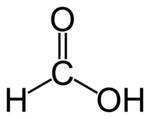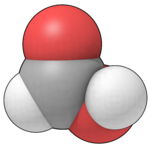Formic acid
2007 Schools Wikipedia Selection. Related subjects: Chemical compounds
| Formic acid | |
|---|---|
  |
|
| General | |
| Systematic name | methanoic acid |
| Other names | formic acid hydrogen carboxylic acid aminic acid |
| Molecular formula | CH2O2 HCOOH |
| SMILES | O=CO |
| Molar mass | 46.0254 g/mol |
| Appearance | colourless, fuming liquid |
| CAS number | [64-18-6] |
| Properties | |
| Density and phase | 1.22 g/cm³, liquid |
| Solubility in water | miscible |
| Melting point | 8.4°C (281.5 K) |
| Boiling point | 100.8°C (373.9 K) |
| Acidity (pKa) | 3.75 |
| Viscosity | 1.57 c P at 26°C |
| Structure | |
| Molecular shape | Planar |
| Dipole moment | 1.41 D(gas) |
| Hazards | |
| MSDS | External MSDS |
| Main hazards | Corrosive |
| NFPA 704 | |
| Flash point | 69°C |
| R-phrases | R10, R35 |
| S-phrases | S1/2, S23, S26, S45 |
| RTECS number | LQ4900000 |
| Supplementary data page | |
| Structure & properties | n, εr, etc. |
| Thermodynamic data | Phase behaviour Solid, liquid, gas |
| Spectral data | UV, IR, NMR, MS |
| Related compounds | |
| Related carboxylic acids | acetic acid propionic acid |
| Related compounds | formaldehyde methanol |
| Except where noted otherwise, data are given for materials in their standard state (at 25°C, 100 kPa) Infobox disclaimer and references |
|
Formic acid (systematically called methanoic acid) is the simplest carboxylic acid. Its formula is CH2O2 or HCOOH.
In nature, it is found in the stings and bites of many insects of the order Hymenoptera, including bees and ants. It is also a significant combustion product resulting from alternative fueled vehicles burning methanol (and ethanol, if contaminated with water) when mixed with gasoline. Its name comes from the Latin word for ant, formica, referring to its early isolation by the distillation of ant bodies. A chemical compound such as a salt from the neutralization of formic acid with a base, or an ester derived from formic acid, is referred to as formate (or methanoate). The formate ion has the formula HCOO−.
Properties
Formic acid is miscible with water and most polar organic solvents, and somewhat soluble in hydrocarbons. In hydrocarbons and in the vapor phase, it actually consists of hydrogen-bonded dimers rather than individual molecules. In the gas phase, this hydrogen-bonding results in severe deviations from the ideal gas law. Liquid and solid formic acid consists of an effectively infinite network of hydrogen-bonded formic acid molecules.
Formic acid shares most of the chemical properties of other carboxylic acids, although under normal conditions it will not form either an acyl chloride or an acid anhydride. Until very recently, all attempts to form either of these derivatives have resulted in carbon monoxide instead. It has now been shown that the anhydride may be produced by reaction of formyl fluoride with sodium formate at −78°C, and the chloride by passing HCl into a solution of 1-formimidazole in monochloromethane at −60°C. Heat can also cause formic acid to decompose to carbon monoxide and water. Formic acid shares some of the reducing properties of aldehydes.
Formic acid is unique among the carboxylic acids in its ability to participate in addition reactions with alkenes. Formic acids and alkenes readily react to form formate esters. In the presence of certain acids, including sulfuric and hydrofluoric acids, however, a variant of the Koch reaction takes place instead, and formic acid adds to the alkene to produce a larger carboxylic acid.
Most simple formate salts are water- soluble.
History
As early as the 15th century, some alchemists and naturalists were aware that ant hills gave off an acidic vapor. The first person to describe the isolation of this substance (by the distillation of large numbers of dead ants) was the English naturalist John Ray, in 1671. Ants secrete the formic acid for attack and defense purposes. Formic acid was first synthesized from hydrocyanic acid by the French chemist Joseph Gay-Lussac. In 1855, another French chemist, Marcellin Berthelot, developed a synthesis from carbon monoxide that is similar to that used today.
In the chemical industry, formic acid was long considered a chemical compound of only minor industrial interest. In the late-1960s, however, significant quantities of it became available as a byproduct of acetic acid production. It now finds increasing use as a preservative and antibacterial in livestock feed.
Production
A significant amount of formic acid is produced as a byproduct in the manufacture of other chemicals, especially acetic acid. This production is insufficient to meet the present demand for formic acid, and some formic acid must be produced for its own sake.
When methanol and carbon monoxide are combined in the presence of a strong base, the formic acid derivative methyl formate results, according to the chemical equation
- CH3OH + CO → HCOOCH3
In industry, this reaction is performed in the liquid phase at elevated pressure. Typical reaction conditions are 80°C and 40 atm. The most widely-used base is sodium methoxide. Hydrolysis of the methyl formate produces formic acid:
- HCOOCH3 + H2O → HCOOH + CH3OH
Direct hydrolysis of methanol requires a large excess of water to proceed efficiently, and some producers perform it by an indirect route by first reacting the methyl formate with ammonia to produce formamide, and then hydrolyzing the formamide with sulfuric acid to produce formic acid:
This technique has problems of its own, particularly disposing of the ammonium sulfate byproduct, so some manufacturers have recently developed energy efficient means of separating formic acid from the large excess amount of water used in direct hydrolysis. In one of these processes (used by BASF) the formic acid is removed from the water via liquid extraction with an organic base.
In the laboratory formic acid can be obtained by heating oxalic acid in anhydrous glycerol and extraction by steam distillation. Another preparation (which must be performed under a fume hood) is the acid hydrolysis of ethyl isonitrile using HCl solution.
-
- C2H5NC + 2H2O → C2H5NH2 + HCOOH
The isonitrile being obtained by reacting ethyl amine with chloroform (note that the fume hood is required because of the overpoweringly objectionable odour of the isonitrile).
Uses
The principal use of formic acid is as a preservative and antibacterial agent in livestock feed. When sprayed on fresh hay or other silage, it arrests certain decay processes and causes the feed to retain its nutritive value longer, and so it is widely used to preserve winter feed for cattle. In the poultry industry, it is sometimes added to feed to kill salmonella bacteria. Other uses:
- It is used to process organic latex (sap) into raw rubber.
- Beekeepers use formic acid as a miticide against the Varroa mite.
- It is of minor importance in the textile industry and for the tanning of leather.
- Some formate esters are artificial flavorings or perfumes.
- It is the active ingredient in some brands of household limescale remover.
In synthetic organic chemistry, formic acid is often used as a source of hydride ion. The Eschweiler-Clarke reaction and the Leuckart-Wallach reaction are examples of this application. It is also used as a source of hydrogen in transfer hydrogenation.
In the laboratory formic acid is also used as source for carbon monoxide, which is set free by the addition of sulfuric acid. Formic acid is also a source for a formyl group for example in the formylation of metylaniline to N-methylformanilide in toluene.
Fuel cells that use modified formic acid are promising.
Safety
The principal danger from formic acid is from skin or eye contact with liquid formic acid or with the concentrated vapors. Any of these exposure routes can cause severe chemical burns, and eye exposure can result in permanent eye damage. Inhaled vapors may similarly cause irritation or burns in the respiratory tract. Since carbon monoxide may be also be present in formic acid vapors, care should be taken wherever large quantities of formic acid fumes are present. The US OSHA Permissible Exposure Level ( PEL) of formic acid vapor in the work environment is 5 parts per million parts of air ( ppm).
Formic acid is readily metabolized and eliminated by the body. Nonetheless, some chronic effects have been documented. Some animal experiments have demonstrated it to be a mutagen, and chronic exposure may cause liver or kidney damage. Another possibility with chronic exposure is development of a skin allergy that manifests upon re-exposure to the chemical.
The hazards of solutions of formic acid depend on the concentration. The following table lists the EU classification of formic acid solutions:
| Concentration by weight |
Classification | R-Phrases |
|---|---|---|
| 2%–10% | Irritant (Xi) | R36/38 |
| 10%–90% | Corrosive (C) | R34 |
| >90% | Corrosive (C) | R35 |

